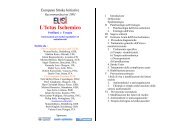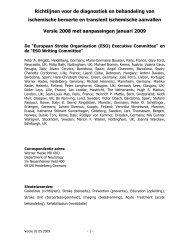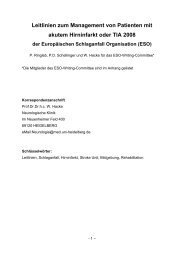Guidelines for Management of Ischaemic Stroke 2008 - ESO
Guidelines for Management of Ischaemic Stroke 2008 - ESO
Guidelines for Management of Ischaemic Stroke 2008 - ESO
Create successful ePaper yourself
Turn your PDF publications into a flip-book with our unique Google optimized e-Paper software.
<strong>ESO</strong>-<strong>Guidelines</strong> <strong>for</strong> <strong>Management</strong> <strong>of</strong> <strong>Ischaemic</strong> <strong>Stroke</strong> <strong>2008</strong><br />
Referral and patient transfer<br />
Recommendations<br />
Immediate EMS contact and priority EMS dispatch are recommended (Class II,<br />
Level B)<br />
Priority transport with advance notification to the receiving hospital (outside and<br />
inside hospital) is recommended (Class III, Level B)<br />
It is recommended that suspected stroke victims should be transported without<br />
delay to the nearest medical centre with a stroke unit that can provide ultra-early<br />
treatment (Class III, Level B)<br />
It is recommended that dispatchers and ambulance personnel be trained to<br />
recognise stroke using simple instruments such as the Face-Arm–Speech-Test<br />
(Class IV, GCP)<br />
Immediate emergency room triage, clinical, laboratory and imaging evaluation,<br />
accurate diagnosis, therapeutic decision and administration <strong>of</strong> appropriate<br />
treatments at the receiving hospital are recommended (Class III, Level B)<br />
It is recommended that in remote or rural areas helicopter transfer should be<br />
considered in order to improve access to treatment (Class III, Level C)<br />
It is recommended that in remote or rural areas telemedicine should be<br />
considered in order to improve access to treatment (Class II, Level B)<br />
It is recommended that patients with suspected TIA be referred without delay to a<br />
TIA clinic or to a medical centre with a stroke unit that can provide expert<br />
evaluation and immediate treatment (Class III, Level B)<br />
Successful care <strong>of</strong> the acute stroke victim begins with the recognition by both the<br />
public and health pr<strong>of</strong>essionals [56] that stroke is an emergency, like acute<br />
myocardial infarction or trauma. However, in practice the majority <strong>of</strong> ischaemic stroke<br />
patients do not receive recombinant tissue plasminogen activator (rtPA) because<br />
they do not reach the hospital soon enough [22, 36, 57, 58]. Emergency care <strong>of</strong> the<br />
acute stroke victim depends on a four-step chain:<br />
• rapid recognition <strong>of</strong>, and reaction to, stroke signs and TIAs<br />
- 10 -





